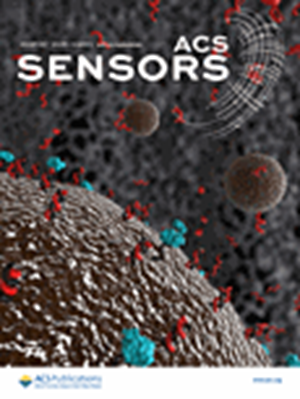Heterostructure of Chemical Vapor Deposition (CVD) Graphene and H2 Plasma-Treated SnO2 Nanoparticle Films for Room Temperature Sensing of SO2.
IF 8.2
1区 化学
Q1 CHEMISTRY, ANALYTICAL
引用次数: 0
Abstract
In this article, we aim to develop SO2 sensors that operate at room temperature (25 °C) by using graphene synthesized through chemical vapor deposition and spin-coated SnO2 films. H2 plasma treatment was applied to the SnO2 films, and photolithography was used to pattern the graphene into interdigital electrodes. We found that the H2 plasma treatment induced oxygen vacancies, hydroxyl groups, and other types of surface states in the SnO2 films. The hydroxyl groups could be an important reason for the onset of p-type conduction in the SnO2 film. When graphene electrodes were deposited on top of the H2 plasma-treated SnO2 film, the SO2 sensor's response was enhanced by nearly 50 times (from 4% to 190%) compared to the sensor based solely on SnO2. Additionally, the response and recovery times were reduced by 34% and 91%, respectively. This performance remained stable even after the sensor had been stored in air for over 2 months. The substrate-mediated effects on the adsorption properties of the exposed graphene surface in the graphene-metal oxide heterostructure, along with the unique properties of the SnO2 film introduced by H2 plasma treatment, highlight new strategies for the future development of room-temperature-operated gas sensors.化学气相沉积(CVD)石墨烯和H2等离子体处理SnO2纳米颗粒薄膜的异质结构用于SO2的室温传感。
在本文中,我们的目标是利用化学气相沉积合成的石墨烯和自旋涂覆的SnO2薄膜,开发在室温(25℃)下工作的SO2传感器。采用H2等离子体处理SnO2薄膜,并采用光刻技术将石墨烯制成数字间电极。我们发现H2等离子体处理在SnO2薄膜中诱导了氧空位、羟基和其他类型的表面态。羟基可能是SnO2薄膜中p型传导发生的重要原因。当石墨烯电极沉积在H2等离子体处理的SnO2薄膜上时,与仅基于SnO2的传感器相比,SO2传感器的响应提高了近50倍(从4%提高到190%)。此外,响应时间和恢复时间分别减少了34%和91%。即使在传感器在空气中储存超过2个月后,该性能仍保持稳定。衬底对石墨烯-金属氧化物异质结构中暴露的石墨烯表面吸附性能的影响,以及H2等离子体处理引入的SnO2薄膜的独特性能,突出了室温操作气体传感器未来发展的新策略。
本文章由计算机程序翻译,如有差异,请以英文原文为准。
求助全文
约1分钟内获得全文
求助全文
来源期刊

ACS Sensors
Chemical Engineering-Bioengineering
CiteScore
14.50
自引率
3.40%
发文量
372
期刊介绍:
ACS Sensors is a peer-reviewed research journal that focuses on the dissemination of new and original knowledge in the field of sensor science, particularly those that selectively sense chemical or biological species or processes. The journal covers a broad range of topics, including but not limited to biosensors, chemical sensors, gas sensors, intracellular sensors, single molecule sensors, cell chips, and microfluidic devices. It aims to publish articles that address conceptual advances in sensing technology applicable to various types of analytes or application papers that report on the use of existing sensing concepts in new ways or for new analytes.
 求助内容:
求助内容: 应助结果提醒方式:
应助结果提醒方式:


